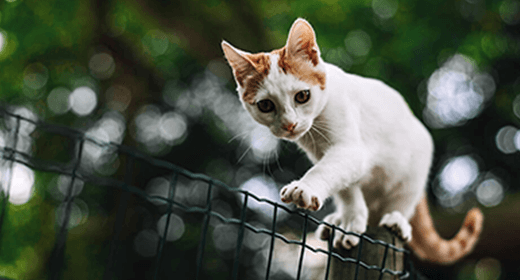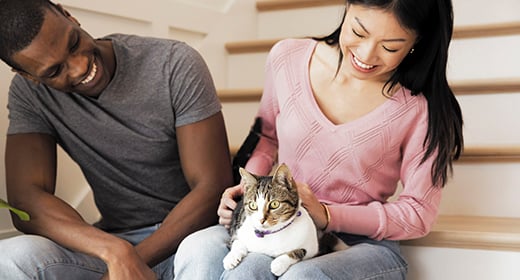

Are you considering feeding a raw diet to your kitten? Before you do, make sure you have the right information. Get the facts about 10 common myths associated with raw meat diets.
FACT: No scientific studies have shown benefits of feeding raw diets to kittens or cats. Their appeal is based on word of mouth, testimonials and perceived benefits.
FACT: Lynxes and other animals in the wild, like wolves, do eat raw meat (in addition to berries, plants, etc.). However, the average lifespan for an animal in the wild is only a few years. Therefore, what is nutritionally “optimal” for a wild animal like a lynx is not optimal for our pets that we hope will live longer and healthier lives.
FACT: Cats, especially kittens, senior cats or immunosuppressed animals, can become infected with Salmonella, Clostridium, Campylobacter and other bacteria found in raw meat diets, just as people can.
FACT: Even meats purchased at the best stores for people can contain harmful bacteria, so purchasing “human-grade” meat does not protect against the health risks of uncooked meats. (Ask yourself: Would you eat raw ground beef?) It is also important to keep in mind that the term “human grade” has no legal definition for pet food.
FACT: Most of the bacteria found in raw meat diets can easily survive freezing and freeze-drying.
FACT: Bones, whether raw or cooked, can fracture your kitten’s teeth. They also can block or tear the esophagus, stomach or intestine.
FACT: All the enzymes dogs and cats (and people) need for digestion are already in the gastrointestinal tract. Additional enzymes from food are not required for digestion.
FACT: Corn, oats, rice, barley and other grains are healthy ingredients that contain protein, vitamins and minerals; they are not added as fillers and are unlikely to cause allergies. Although meat is an important component of diets for kittens and cats, grains can be part of a high-quality, nutritionally balanced diet.
FACT: Byproducts are the animal parts American people don’t typically eat, such as livers, kidneys or lungs — in other words, the organs and meats other than animal muscle. Note that some pet foods may actually list these ingredients (e.g., duck liver, beef lung), but these are really just byproducts. Most commercial and many home-prepared raw diets also contain by products.
FACT: Most homemade (and even some commercial) raw meat diets are extremely deficient in calcium and a variety of other nutrients, even if chicken necks, bones or eggshells are added. This can be disastrous for any animal but especially for young, growing kittens, and can result in fractured bones. For complete and balanced nutrition, feed your cat a high-quality kitten food like IAMS™ ProActive Health™ Healthy Kitten.


Bringing a kitten home is an experience full of joy and warmth. The internet is filled with kitten photos and videos, and you are soon going to find out why! However, these cute creatures are extremely delicate and need hands-on attention while growing up. If you bring home a kitten without a mother, you will have to be extra careful with it. Every cat parent should be well-informed about how to take care of newborn kittens or kittens in general.
We have put together a few tips to get you started on your journey of raising a kitten. From vet visits and food selection to grooming and keeping it hydrated, this article will give you a basic understanding of how to take care of a kitten.
Routine check-ups are highly recommended for kittens. Once you get a kitten home, your responsibility as a caregiver is to take it to the vet for a basic health check-up. During this check-up, the veterinarian will check for any health concerns that need to be addressed immediately. They will also walk you through the vaccination and spaying/neutering process. If you are a first-time cat parent, do not hesitate from asking doubts and questions regarding your cat’s health and well-being.
Since a dehydrated kitten can be vulnerable to many diseases and infections, make sure that fresh water is easily accessible. In fact, place multiple water bowls around the house for it to drink from. Clean these bowls regularly and fill them up with fresh water. If the vet recommends, you can also give your kitten electrolyte water.
A newborn kitten should be fed by its mother for the first few weeks. However, kitties that find a new home generally get separated from their mother at an early age. If you have adopted a newborn pet, you probably do not know how to take care of a kitten without a mother. Start by visiting a vet to receive a comprehensive feeding guide. It will help you meet the kitty’s nutritional needs. You might also have to switch to a different type of food at different stages like teething.
Cats are carnivores; hence, their food intake is majorly meat. Ensure that the dry food you give your cat is made with high-quality protein. Made with chicken as the main ingredient, IAMS Proactive Health Mother and Kitten is a protein-rich meal option for your kitten. This kitten food also contains Omega 3, Colostrum, and DHA to support healthy eye and brain development!
Cats are independent creatures that enjoy their space. However, from time to time, they also like being cuddled and picked up. They will also show affection in their own unique ways. Give your kitten some time to settle in and gradually start introducing it to your touch. Gently hold it and pamper it. Bring a few fun toys for it to play with. Kittens generally love playing with bells, strings, or anything that they can chase.
Taking care of a kitten involves introducing it to its new family members – including other pets – from the day it is brought home. After all, your new kitten will be the newest addition to the clan! If you are worried about your dog and cat not getting along because of age-old assumptions, let us assure you, it is nothing but a myth. However, some dogs may not be able to differentiate a cat from a rabbit and their prey instincts could kick in. If this happens, you need to train your dog by familiarising it with your kitten’s scent. Most dog breeds are hostile in nature and can coexist with other pets easily. Socialising for your kitten will also include grooming days, check-up days, and more.
Cats love grooming themselves and are very particular about how they look. However, kittens may need some help, especially in cases where they dirty themselves. Your vet will educate you about ways in which you can give your delicate and tiny kitten a bath. Post that, brush your kitten’s fur coat. Now, brushing its coat does not only remove dirt and dead hair, but it also regulates blood circulation, giving your kitty a healthy glow!
Litter training is one of the most important aspects of raising a kitten. Choose a litter box that is big enough for your kitten to do its business. Finding the right type of litter may take some experimenting, but you will soon get there! Fortunately, cats usually eliminate in sandy or granular places by nature. So, when you introduce it to a litter box, chances are that it will use it right away. If your feline friend doesn’t, give it some time to get comfortable. Keep cleaning the litter box periodically to ensure hygiene.
As a cat parent, you must pay attention to your kitty’s sleeping space. Kittens and cats are heavy sleepers; kittens can even sleep for 20 hours a day! For the first few nights, make sure your kitten sleeps next to your bed. It is normal for these feline creatures to cry during the first few days as everything is new. However, your kitten will eventually start getting used to its new space and sleep for long hours. Once it starts doing that, you can set up a cosy corner for it to sleep in. If you are wondering how to take care of a newborn kitten, just make sure that you place it somewhere near your bed. This will help you hear any cries and come to their aid as soon as possible.